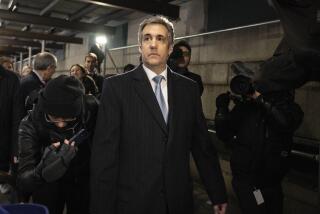Lay, Skilling Lawyers May Have Time on Their Side
- Share via
HOUSTON — Two weeks into the high-stakes fraud-and-conspiracy trial of former Enron Corp. Chairman Kenneth L. Lay and former Chief Executive Jeffrey K. Skilling, legal experts say the government has done a decent job of setting the table, but the defense is threatening to run off with the china.
The government’s crucial opening witness, former Enron investor relations chief Mark E. Koenig, though rattled at times and forced to concede factual errors, has given up little ground on the main points of his testimony: that Lay and Skilling made or approved of misleading public statements meant to conceal flaws beneath the energy-trading company’s gleaming surface.
However, the clock is the defense’s friend, and Skilling’s and Lay’s lawyers have succeeded in stretching out Koenig’s time on the stand, introducing several hourlong audiotapes and videotapes and reams of transcripts. Koenig has spent four stressful days under cross-examination -- twice as long as his questioning by prosecutors -- with at least another full day to come when the trial resumes today.
“The defense is trying to hijack the government’s case,” said James D. “Jamie” Wareham, global head of litigation for Paul, Hastings, Janofsky & Walker in Washington. “They know that if this case goes four months, the jury will blame the government.”
Indeed, after the jury had been dismissed Wednesday, co-prosecutor Kathryn H. Ruemmler complained to U.S. District Judge Sim Lake that the tapes -- which the defense has insisted on playing to show “context” -- had disrupted the government’s presentation. Lake responded by ruling out a few of the tapes that Lay’s chief lawyer, Michael W. Ramsey, had wanted to play during his cross-examination of Koenig, which began Thursday afternoon.
Lay is charged with seven counts of conspiracy and making false statements; Skilling faces 31 counts of conspiracy, making false statements and insider trading. Conviction could mean decades in prison for both men.
The prosecution led off with Koenig because he was a senior executive for the entire period covered by the indictment and personally attended most of the meetings or conference calls during which Lay or Skilling allegedly made misleading statements, said Marc D. Powers, a securities law expert with Baker & Hostetler in New York.
“He sets up the case for them because he can provide the full story from beginning to end,” Powers said. Although others on the prosecution’s witness list may have more detailed knowledge of particular incidents, he said, they weren’t as well positioned to see the big picture.
That approach carries risks, though. Because trial procedure limits cross-examination to areas discussed in direct examination, painting a broad landscape as the government did with Koenig “gives the defense almost unlimited scope to ask what they want,” Paul Hastings’ Wareham said.
Had he been opening the government’s case, Wareham said, “I would’ve stuck ‘em in the eyeball with the single most damaging thing I had and left it at that.”
Koenig is a slender 6-foot-3 with close-cut red hair, wire-rimmed glasses and a light complexion that shows color easily. During co-prosecutor Ruemmler’s direct examination, he often gestured with his hands as he explained financial terms or discussed life at Enron.
Once Skilling’s head lawyer, Daniel M. Petrocelli of Los Angeles, began his cross-examination, however, Koenig grew visibly more strained, using fewer oratorical gestures, more often putting a quick hand to his ear or eyeglasses in an apparently reflexive motion. Sometimes his color rose, as when he briefly lost composure after Petrocelli asked him a question about his three children.
Petrocelli began his attack last Monday and finished it Thursday by hitting the same point: that Koenig was motivated to shade his testimony in the government’s favor. The lawyer focused on Koenig’s cooperation agreement, showing that the government had broad discretion over whether Koenig would serve years in prison or perhaps escape it entirely. As Petrocelli put it to him: “Your life is on the line.”
Petrocelli then drilled down into the facts underlying Koenig’s statements that Lay and Skilling had lied or misled investors. He tried wherever possible to catch Koenig in an inconsistency or factual error by comparing his statements with financial records and recordings of Lay’s and Skilling’s presentations.
It was here that Koenig showed his toughness and that Petrocelli sometimes bogged down. For example, Koenig testified that a $150-million gain on a single dot-com stock had once constituted the entire quarterly revenue for Enron’s fledging retail energy-services unit but that the company fudged its statements to make it look as though the money came from regular business operations.
Petrocelli spent about half an hour laboriously forcing Koenig to concede that there had actually been two investment gains that quarter, the second amounting to about $1 million.
“If you’re going to shoot, shoot to kill,” said Mark C. Zauderer, a business litigation specialist based in New York. “You’ve got to make sure that a witness’ failure of recollection is an important one. If not, the jury may draw the conclusion that you have nothing more substantive, and it may actually bolster his credibility.”
On the other hand, just taking the time to make such points could ultimately work in the defense’s favor if, some months down the road, the jury starts to resent the time it has put in, Wareham said.
“The government is off to an OK start,” he said. “Nobody’s irritated the judge. The jury’s awake. But if I were the government, I’d be looking to pare down this case.”
More to Read
Inside the business of entertainment
The Wide Shot brings you news, analysis and insights on everything from streaming wars to production — and what it all means for the future.
You may occasionally receive promotional content from the Los Angeles Times.










